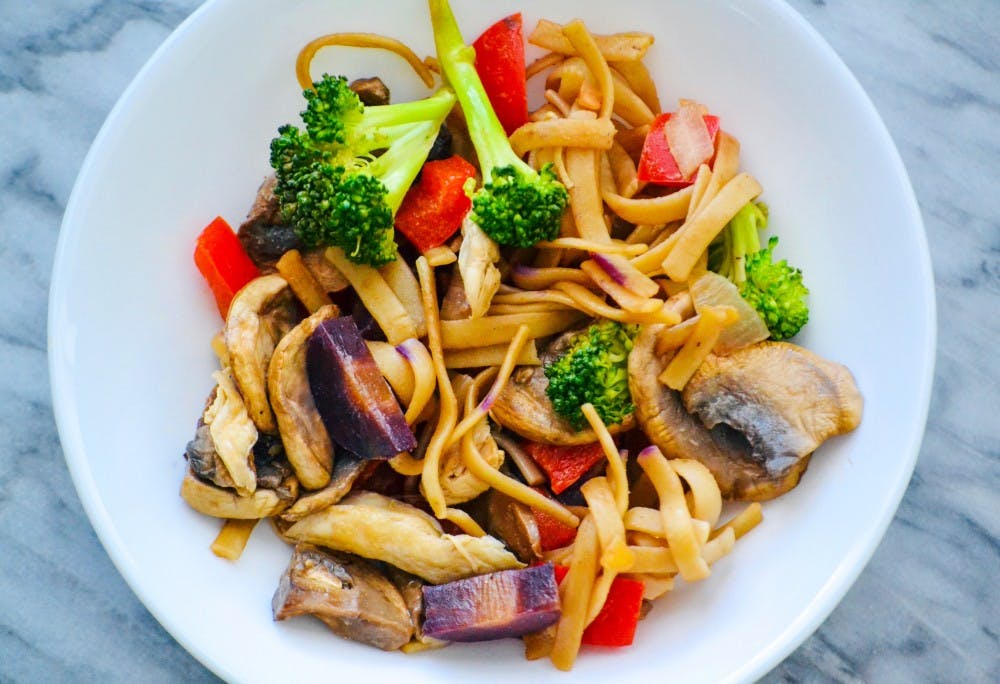Let’s be real here — pad Thai is a life-changing meal. Pad Thai combines the right amount of flavor with slurpable noodles to create an incredible dish.
One of my favorite pastimes is taking my favorite dishes and remaking them using healthy ingredients. The truth is, while I love some traditional restaurant food and respect traditional recipes, I end up liking healthier takes a lot better most of the time. So of course, I was inspired to create a healthy version of pad Thai.
My remakes tend to be filled with extra vegetables — something the average college student could always use in their diet — while maintaining the original great flavor. However, the best part of my new recipes may be how minimal and simple the ingredients are compared to restaurants’ recipes. I am passionate in my belief that food doesn’t have to be complex to be good. Real, whole ingredients are the basis of nutritious food, so why not stick to them?
I’ve been making this pad Thai recipe repeatedly lately. It is one I came up with after browsing the internet and seeing lots of different healthy variations, such as this recipe from the vegetarian food blog “Cookie and Kate.” I love this recipe because I can mix it up by changing the protein, vegetables and noodles. Also, I can make a big batch, giving me leftovers to reheat throughout the week. The recipe can also be made vegetarian simply by omitting meat.
This recipe can be considered a healthy alternative because I use non-MSG versions of typical soy sauce and coconut ingredients. MSG is an unhealthy flavor enhancer made of sodium and is often found in ingredients used in pad Thai. This recipe also has a more natural, nutty taste due to the addition of peanut butter instead of other starches used to thicken sauces. Additionally, the use of brown rice noodles make for a healthier alternative than regular rice noodles. Brown rice noodles pack protein and digestive fiber to keep you full for longer periods of time.
Without further ado, I present to you the healthy pad Thai of your dreams.
Prep Time: 10-20 minutes
Cook Time: 10-20 minutes
Ingredients:
1/2 onion, chopped
1/2 bag of snap or sugar peas, chopped
1 bell pepper, chopped (orange, red, yellow or green works)
2 carrots, cut
1 large crown of broccoli
1/2 - 1 package of mushrooms, sliced
1 package of brown rice noodles. I like the Lotus Foods brand, but you can also get black rice noodles to change it up.
1 - 2 tbsp neutral cooking oil (coconut or avocado work best)
1 lime for topping
Peanuts for topping
Bean sprouts for topping if you’re feeling fancy
Chicken, shrimp, tofu, tempeh or other protein of choice
*You can add any vegetables you prefer
For the sauce:
3 tbsp tamari
3 tbsp honey or maple syrup
1.5 tbsp peanut butter — crunchy is preferred
1/4 cup vegetable or chicken broth if not vegan or vegetarian
1/4 cup coconut aminos or liquid aminos — these are soy-sauce alternatives that are lower in sodium
Directions:
1. Prepare all your veggies by rinsing and chopping and rinse your protein of choice so it is ready to cook.
2. Create your sauce in a small dish by mixing the sauce ingredients and set aside.
3. Cook the brown rice noodles on the stove in boiling water in a pasta pot for a couple minutes. Then drain and set aside. The package the noodles come in usually mentions how long to cook the noodles. Meanwhile, heat up a skillet to medium and spread oil around the skillet. Once hot, add the protein and cook thoroughly. For chicken, this is generally five to six minutes or past the point when no pink remains.
4. Set aside the chicken onto a plate when done and add vegetables to the pan to cook fully.
5. Once browned, set aside the veggies, lower heat and add the noodles to the pan along with half of the sauce. Make sure to stir the noodles constantly. Once the noodles begin to soak up the sauce, you can add in the veggies and protein along with the rest of the sauce. Continue to stir.
6. The noodles, vegetables and protein should soak up the majority of the sauce after a few minutes. Then, turn off the heat and serve. This dish should make about four servings. If you manage not to eat it all in one sitting, feel free to share with others or store as leftovers.
This dish is as versatile in the serving size and ingredient options as it is healthy. I have made it just for myself, for my whole family and for leftovers for quick dinners throughout the week. Make sure you give this dish a try, and let me know what you think.
Isabel Salken is a food columnist for The Cavalier Daily. She can be reached at life@cavalierdaily.com.







